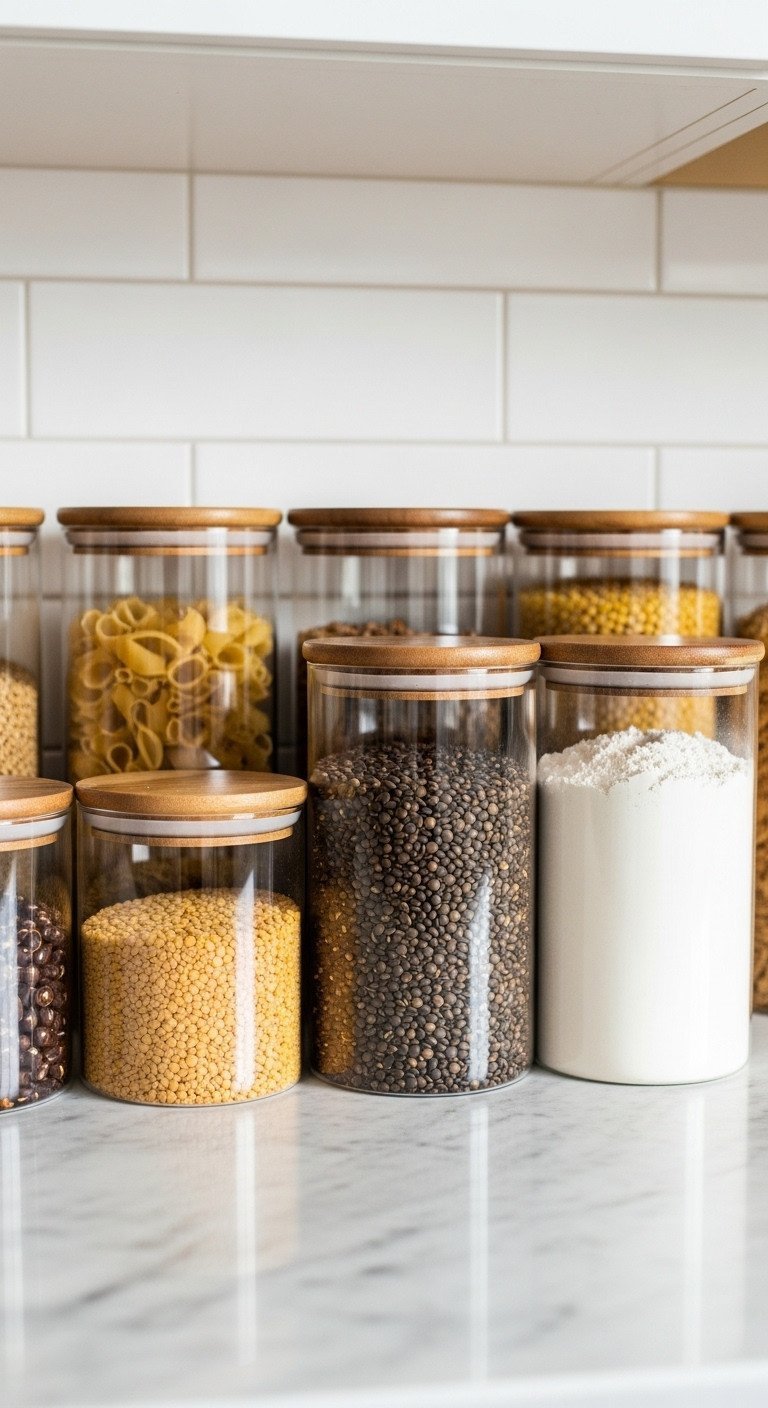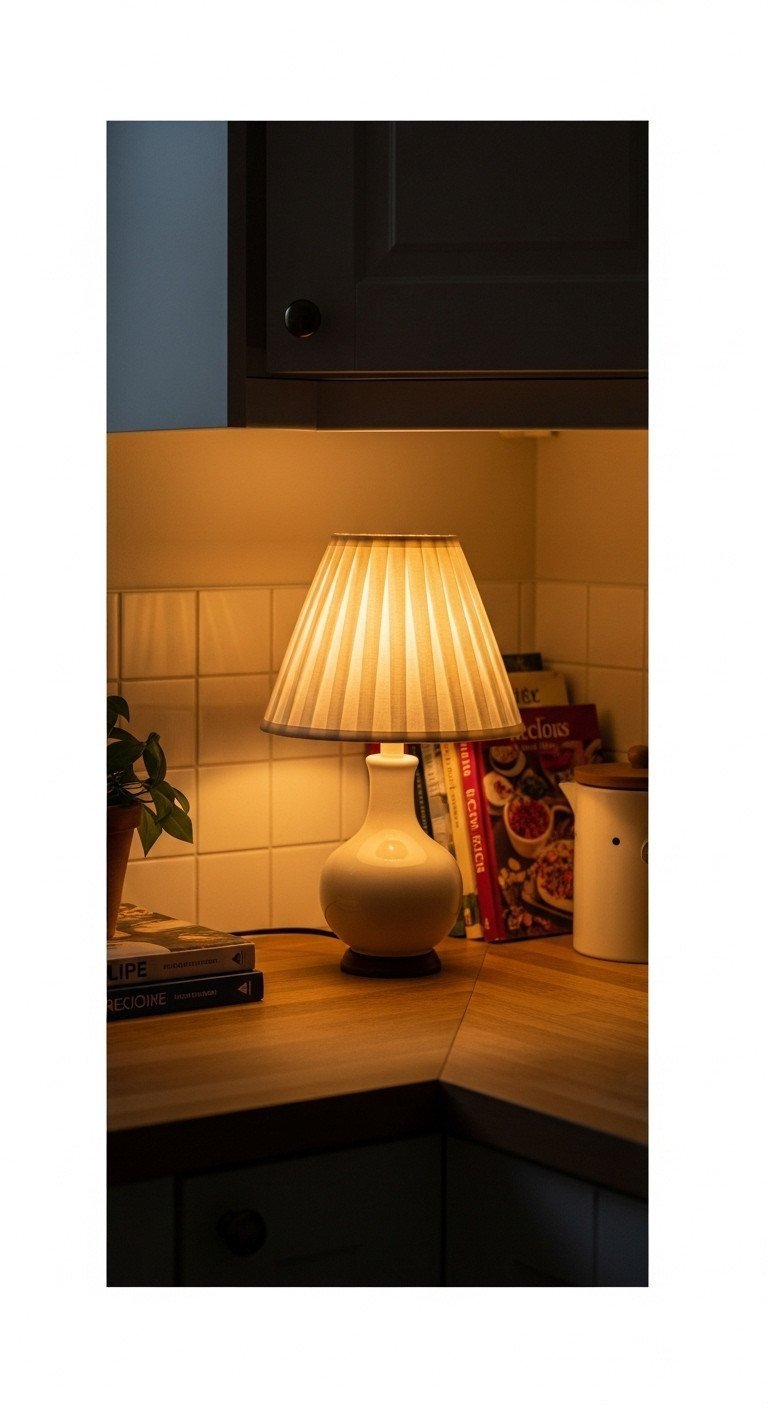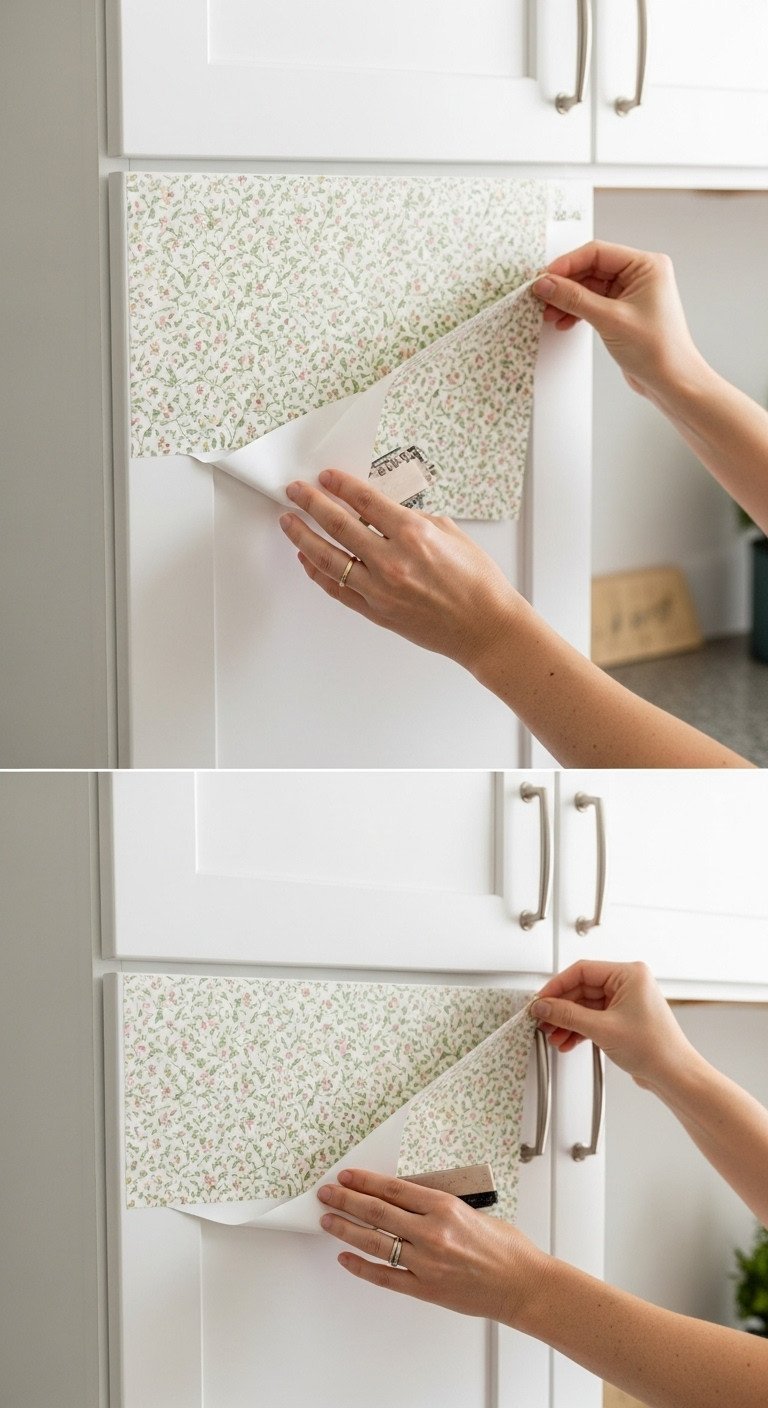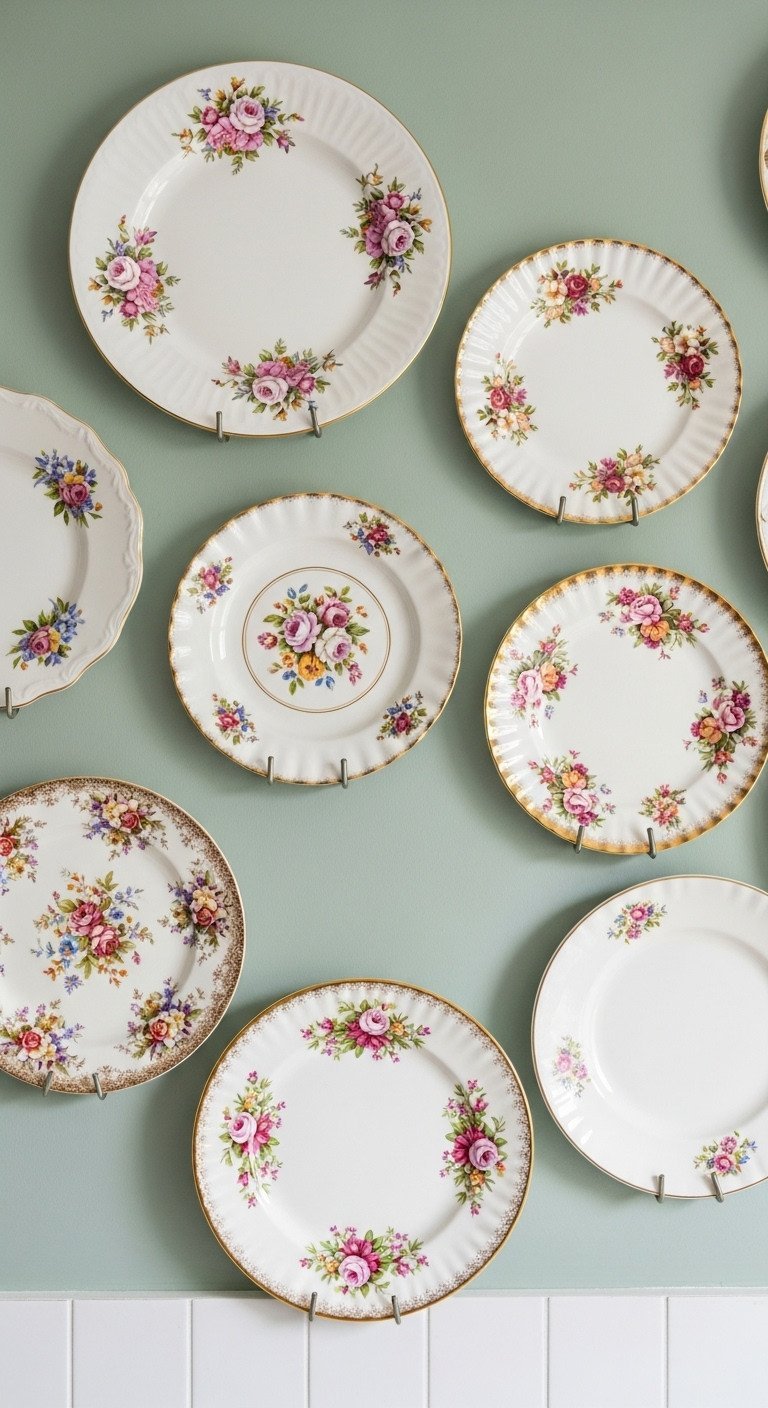As an Amazon Associate KitchenwareSets.com earns from qualifying purchases.
13 Cozy Cottagecore Kitchen Ideas For A Small Apartment
Struggling to feel at home in your generic rental kitchen? You’re not alone. The cottagecore aesthetic, a design style inspired by romanticized country life, is the perfect solution for turning a sterile space into a personal sanctuary. It’s all about warmth, character, and lived-in charm.
A cottagecore kitchen is a design style that creates a cozy, nostalgic atmosphere using natural materials, vintage finds, and floral patterns. This guide will walk you through 13 simple, renter-friendly ideas. You’ll discover how to transform your small apartment kitchen into a charming retreat.
Is Your Apartment Kitchen Feeling a Little… Lifeless?
We’ve all been there—staring at the builder-grade cabinets, the boring beige walls, and the generic hardware. An apartment kitchen can often feel temporary and impersonal, lacking the warmth and character that makes a house feel like a home. You want a space that reflects your personality, a cozy nook for your morning coffee, but feel limited by rental agreements and a small budget.
This is where the cottagecore kitchen aesthetic comes in. It’s not about expensive renovations; it’s about layering charm through simple, actionable, and often DIY kitchen updates. A cottagecore kitchen is a design style focused on creating a cozy, charming, and nostalgic atmosphere inspired by romanticized country life. It emphasizes natural materials, vintage finds, floral patterns, and a warm, lived-in feel, making it perfect for personalizing small spaces. This guide will give you 13 beautiful ideas to do just that.
13 Cozy Cottagecore Kitchen Ideas To Charm Your Small Apartment
Ready to transform your kitchen from bland to beautiful? Each of these cottagecore kitchen ideas is designed with small apartment spaces and renter constraints in mind. These are not major renovations, but small, impactful projects that anyone can tackle. From simple hardware swaps to charming textiles, you’ll find everything you need to create a warm, welcoming, and whimsical kitchen you’ll absolutely love spending time in.
1. Install Charming Cafe Curtains

Pin this charming idea to your ‘Apartment Kitchen’ board!
Nothing says “cozy cottage” quite like soft curtains filtering sunlight into your kitchen. Cafe curtains cover only the bottom half of the window, giving you privacy from neighbors while still letting in tons of natural light. This renter-friendly window treatment requires no drilling and instantly adds a layer of softness and pattern.
Materials Needed:
- Cafe curtains (cotton or linen with a floral or gingham pattern)
- A spring-loaded tension rod that fits your window width (no screws required)
- Measuring tape
Step-by-Step Directions:
- Measure the width of the inside of your window frame.
- Purchase a tension rod that adjusts to fit that width.
- Choose cafe curtains that are roughly 1.5 times the width of your window for a nice, gathered look.
- Slide the curtain panels onto the tension rod.
- Twist the rod to shorten it, place it inside the window frame at your desired height (usually halfway up), and then extend it until it’s snug and secure.
Pro-Tip: For a no-sew DIY version, buy a charming tea towel or a yard of fabric and use iron-on hemming tape to create a pocket for the tension rod.
2. Swap Out Generic Cabinet Hardware

Save this easy 1-hour kitchen upgrade!
This is one of the easiest and most impactful changes you can make. Swapping builder-grade silver knobs for antique cabinet hardware like vintage-style ceramic knobs or brass cup pulls completely transforms the look of your cabinets, making them feel custom and full of character. It’s a simple, affordable, and 100% reversible update.
Materials Needed:
- New cabinet knobs or pulls (vintage-style ceramic or unlacquered brass are great choices)
- Screwdriver
- Measuring tape (only if switching from knobs to pulls)
Step-by-Step Directions:
- Count the number of cabinet doors and drawers you need hardware for.
- Unscrew the existing knob or pull from the inside of the door/drawer.
- Crucial Renter Tip: Place all the original hardware and screws in a labeled bag and store it somewhere safe for when you move out.
- Screw your new hardware into the existing hole. If it’s a knob, you’re done!
- If you’re switching from a knob to a pull with two screws, you’ll need to drill a second hole. Use a hardware template for perfect alignment.
Pro-Tip: Before buying pulls, measure the center-to-center distance of the screw holes on your existing ones to ensure the new ones are a direct replacement, avoiding any new drilling.
3. Apply a Faux-Tile Peel-and-Stick Backsplash

Pin this amazing renter-friendly backsplash hack!
If you’re stuck with a plain or dated backsplash, a peel-and-stick version is a game-changer. Modern options look incredibly realistic and come in beautiful floral or vintage-inspired patterns that are perfect for a cottagecore kitchen. This is a fantastic way to add a major dose of personality without any grout, mess, or damage to the wall underneath.
Materials Needed:
- High-quality peel-and-stick tile sheets (water and heat-resistant vinyl is best for kitchens)
- Degreasing cleaner (like TSP or simple green) and a cloth
- Utility knife or sharp scissors
- Ruler or straight edge
Step-by-Step Directions:
- Thoroughly clean the existing wall or backsplash with a degreaser to ensure the new tiles adhere properly. Let it dry completely.
- Measure your backsplash area and calculate how many tile sheets you’ll need.
- Start in a corner. Peel back a small portion of the backing paper from the first tile sheet.
- Carefully align the sheet with the corner of the wall and the countertop, then press it firmly onto the wall, smoothing from the center outwards to remove air bubbles.
- For the next sheet, overlap the “grout” lines as indicated by the manufacturer to create a seamless look.
- Use a utility knife and ruler to cut tiles to fit around outlets and at the end of a row.
Lesson Learned: Buy about 10% more tile sheets than you calculate you need. This covers any cutting mistakes and ensures you have extras from the same batch for a perfect color match.
4. Style an Open Shelf with Curated Charm

Love this shelf styling? Pin it for inspiration!
Open shelving is a hallmark of cottagecore kitchen decor. It’s the perfect spot to display your favorite mismatched china, vintage finds, and other pretty-yet-practical items. The key is to style it with intention so it looks curated, not cluttered. If you don’t have built-in shelves, adding a single rustic wood floating shelf is an easy project.
Materials Needed:
- Your prettiest and most-used items: mugs, plates, bowls
- Decorative objects: a small plant, a framed art print, a candle
- Varied textures: a small wooden cutting board, a ceramic vase
- A floating shelf (if you don’t already have one)
Step-by-Step Directions:
- Start with an Anchor: Place your largest item first, like a stack of plates or a leaning art print, usually off-center.
- Create Triangles: Arrange items in visual triangles of varying heights. For example, a tall vase, a medium stack of bowls, and a short mug. This guides the eye and creates balance.
- Layer Front to Back: Don’t line everything up. Lean a small plate or art print against the back wall, and place a shorter object in front of it.
- Mix Materials: Combine smooth ceramics with rough wood, shiny metal, and soft greenery for textural interest.
- Edit Ruthlessly: Step back and remove one item. Open shelving often looks best when it has a little room to breathe.
Pro-Tip: Stick to a consistent color palette of 2-3 main colors for your shelf display. This will make even mismatched, thrifted items look cohesive and intentional.
5. Create a Windowsill Herb Garden

Pin this fresh idea for bringing nature indoors!
A core part of the cottagecore aesthetic is the connection to nature. An indoor herb garden on your sunlit windowsill is the perfect way to incorporate nature indoors. It adds life, color, and fresh scents to your kitchen, not to mention providing fresh ingredients for your cooking. Using mismatched terracotta or ceramic pots enhances the collected-over-time charm.
Materials Needed:
- 2-3 small pots with drainage holes (mismatched terracotta pots are perfect)
- Potting soil
- Herb seedlings (basil, mint, parsley, and rosemary are easy to grow indoors)
- Small saucers or trays to catch water
Step-by-Step Directions:
- Place a small layer of gravel or broken pottery at the bottom of each pot for better drainage, if desired.
- Fill the pots about two-thirds full with potting soil.
- Gently remove an herb seedling from its nursery container, loosen the roots slightly, and place it in the new pot.
- Add more soil around the seedling until it’s secure, leaving about an inch of space at the top of the pot.
- Water thoroughly and place the pots on their saucers on your sunniest kitchen windowsill.
- Water whenever the top inch of soil feels dry.
Pro-Tip: Can’t commit to live plants? Find high-quality faux herbs in rustic pots for the same look with zero maintenance.
6. Decant Pantry Staples into Pretty Jars

Save this simple trick for beautiful, functional decor!
Turn everyday ingredients into decor. Decanting pantry staples like flour, pasta, and oats from their busy, branded packaging into uniform glass pantry jars instantly calms visual clutter. This simple act of organization creates a beautiful display on your countertop or open shelves, adding to the rustic, from-scratch feeling of a cottage kitchen.
Materials Needed:
- A set of glass jars with airtight lids (wood or cork lids add a rustic touch)
- Pantry staples like flour, sugar, oats, pasta, rice, and lentils
- Optional: A funnel for easy pouring
- Optional: Kraft paper tags and twine for charming, removable labels
Step-by-Step Directions:
- Wash and thoroughly dry your new jars and lids.
- One by one, decant your pantry staples from their original bags and boxes into the glass jars. Use a funnel to minimize mess.
- If using labels, write the name of the ingredient on a tag and tie it around the neck of the jar with twine.
- Arrange the jars neatly on your countertop or an open shelf. Group them by height or usage for a pleasing look.
Pro-Tip: Keep a small, erasable marker nearby to write the expiration date on the bottom of the jar each time you refill it.
7. Use Woven Baskets for Fruits and Veggies

Pin this beautiful and practical storage idea!
Woven baskets are a cottagecore storage staple. They add essential natural texture and warmth to the kitchen. Use a shallow wicker basket on the countertop for apples and citrus, or a tiered hanging basket to store onions and potatoes, freeing up valuable counter and cabinet space.
Materials Needed:
- A single woven basket or a multi-tiered hanging basket
- Fresh produce that can be stored at room temperature (onions, garlic, potatoes, apples, bananas, citrus)
- For hanging baskets: A ceiling hook and the ability to install it
Step-by-Step Directions:
- For Countertop Storage: Simply choose a shallow woven bowl or basket and arrange your fruits (like apples and oranges) in it to create a beautiful, edible centerpiece.
- For Vertical Storage: Install a secure hook into a ceiling joist in a corner of your kitchen.
- Hang your tiered basket from the hook.
- Fill the baskets with produce. It’s best to keep ethylene-producing items (like bananas and apples) separate from ethylene-sensitive items (like onions and potatoes) to prevent premature ripening. Place heavier items like potatoes in the bottom basket.
Lesson Learned: Natural fiber baskets allow for air circulation, which helps keep produce like onions, garlic, and potatoes fresh for longer than storing them in a closed cabinet.
8. Hang Vintage-Inspired Botanical Art

Save this idea for adding instant personality to a blank wall!
Don’t let blank walls go to waste. Creating a small-scale gallery wall with vintage-inspired art is a perfect way to add personality. Scour thrift stores for mismatched gold and wood frames, and print free botanical illustrations from online public domain archives. This affordable project adds a touch of sophistication and charm.
Materials Needed:
- Botanical art prints (you can download and print free vintage illustrations from public domain archives online)
- A collection of small, mismatched frames from a thrift store
- Removable picture-hanging strips for damage-free installation
Step-by-Step Directions:
- Source Your Art: Search online for “public domain botanical illustrations.” Download and print your favorites on good quality matte cardstock.
- Find Your Frames: Go to a local thrift store and collect 3-5 small frames in different styles (gold, oval, rustic wood). Don’t worry if they’re not perfect; a little wear adds character.
- Assemble: Place your prints into the frames.
- Arrange: Lay the framed pictures out on the floor to plan your arrangement before putting them on the wall. A tight cluster often looks best for small walls.
- Hang: Use removable picture-hanging strips, following the package instructions, to hang your art without making any holes in the wall.
Pro-Tip: Look for art that follows a theme, such as kitchen herbs, wildflowers, or mushrooms, to create a cohesive mini-gallery.
9. Add a Small, Warm Countertop Lamp

Pin this secret for making any kitchen feel cozier!
The secret to a truly cozy kitchen is layered lighting. Harsh overhead lights can feel sterile. Combat this by placing a small, vintage-style table lamp in a corner of your countertop. The warm, ambient glow it provides in the evenings will completely change the atmosphere of your kitchen, making it feel incredibly inviting and serene.
Materials Needed:
- A small table lamp with a charming base (ceramic, wood, or brass)
- A fabric shade (pleated or patterned shades are very cottagecore)
- A warm-white light bulb (look for 2700K color temperature)
Step-by-Step Directions:
- Identify a corner of your countertop that isn’t used for food prep, preferably one near an outlet.
- Find a small lamp—the base should be no more than 5-6 inches in diameter to avoid taking up too much space.
- Choose a shade that complements your kitchen’s color scheme.
- Use a warm-white LED bulb. Avoid cool, blue-toned light, which can feel sterile.
- Place the lamp in the corner and enjoy the soft, cozy glow it creates. It’s perfect for early mornings or late evenings when you don’t need the bright overhead lights.
Pro-Tip: If outlet space is an issue, consider a rechargeable, battery-operated lamp for maximum flexibility.
10. Cover Dated Cabinets with Removable Wallpaper

Save this genius hack for ugly rental cabinets!
If painting your cabinets isn’t an option, removable wallpaper is your best friend. This temporary makeover solution is perfect for covering dated or plain flat-front cabinets. Choose a delicate floral or gingham pattern to instantly inject cottagecore charm into your kitchen. It’s a bit of a project, but the results are dramatic and completely reversible.
Materials Needed:
- A roll of high-quality, removable peel-and-stick wallpaper
- Screwdriver (to remove hardware)
- Degreasing cleaner and cloth
- Measuring tape, ruler, and a sharp craft knife
- A plastic smoothing tool or credit card
Step-by-Step Directions:
- Use the screwdriver to remove the cabinet doors and all hardware. Lay the doors on a flat surface.
- Thoroughly clean the cabinet fronts with a degreaser to remove any grime. Let them dry completely.
- Measure a cabinet door and cut a piece of wallpaper that is slightly larger on all sides.
- Peel back a few inches of the backing and align the wallpaper with one edge of the cabinet door.
- Slowly press the wallpaper down, using the smoothing tool to push out any air bubbles as you go.
- Once the front is covered, wrap the excess around the edges for a clean look. Use the craft knife to trim away any extra paper and make a small hole where the hardware screw goes.
- Re-attach the hardware and re-hang the door.
Lesson Learned: This works best on flat-front cabinets. If your cabinets have detailed molding, consider just applying the wallpaper to the recessed center panel for an easier, charming effect.
11. Display a Collection of Mismatched China

Pin this beautiful way to display thrift store treasures!
Turn thrifted treasures into art. A collection of mismatched vintage floral plates can become a stunning feature on a blank wall. This is an incredibly affordable way to create unique cottagecore wall decor that tells a story. Look for plates with a common color or theme to tie them all together.
Materials Needed:
- A collection of 3-5 vintage plates (look for them at thrift stores and flea markets)
- Adhesive plate hangers or traditional wire plate hangers
- A blank wall space
Step-by-Step Directions:
- Curate Your Collection: Gather plates that have a similar color palette or theme (e.g., all have pink flowers, or all have gold rims) to ensure they look cohesive together.
- Plan Your Layout: Trace the plates onto paper, cut them out, and tape the paper circles to the wall to perfect your arrangement before making any holes. A gentle curve or a staggered cluster looks great.
- Choose Your Hanger: For a totally damage-free option, use adhesive plate hangers that stick to the back of the plate and have a hook. For heavier plates, use traditional spring-loaded wire hangers.
- Hang Securely: Follow the hanger instructions to mount your plates on the wall according to your planned layout.
Pro-Tip: If you can’t put nails in your wall, you can still get this look by using small, clear easels to display a few favorite plates on an open shelf or on top of your cabinets.
12. Soften with Charming Kitchen Textiles

Save this simple tip for adding instant softness and color!
Kitchens are full of hard surfaces. The easiest way to add cottagecore softness is with textiles. A pretty gingham or floral tea towel draped over the oven handle, a small jute rug in front of the sink, or a simple tablecloth can instantly add color, pattern, and a cozy, lived-in feel to the entire room.
Materials Needed:
- A set of pretty tea towels in a cottagecore pattern (floral, gingham, stripes)
- A small, washable rug or runner (jute, rag rugs, or patterned cotton work well)
- Optional: A small tablecloth or runner for a kitchen table or cart
Step-by-Step Directions:
- Towel Time: Ditch the plain terrycloth and hang a beautiful cotton or linen tea towel from your oven or dishwasher handle. It’s a tiny detail that makes a big impact.
- Soften the Floor: Place a small, durable rug in front of the sink. This not only adds color and texture but also provides comfort while you’re doing dishes.
- Cover a Surface: If you have a small kitchen cart or bistro table, cover it with a simple gingham or floral tablecloth to create a major focal point.
- Coordinate, Don’t Match: Choose textiles that share a common color but have different patterns (e.g., a red floral tea towel with a red gingham rug) for a collected, charming look.
Pro-Tip: Look for tea towels at craft fairs or on Etsy for unique, handmade designs that add extra personality.
13. Lean a Rustic Wooden Cutting Board

Pin this simple styling trick for instant warmth!
This is perhaps the simplest styling trick for instant cottagecore warmth. Instead of hiding your wooden cutting boards away, lean one or two against your backsplash. They add an immediate layer of rustic texture and natural material. It’s a functional decor piece that makes your kitchen feel like a well-loved workspace.
Materials Needed:
- One or two wooden cutting boards of different shapes and sizes
- Optional: Food-grade mineral oil
Step-by-Step Directions:
- Find a Board: Look for a cutting board with character—an interesting shape, a warm wood tone, or a handle. Thrift stores often have beautiful, aged ones.
- Condition It: If your board looks dry, revive it by wiping a thin layer of food-grade mineral oil all over it with a soft cloth. Let it soak in, then wipe off any excess. This brings out the rich color of the wood.
- Lean and Layer: Simply lean the cutting board against your backsplash behind other countertop items like a utensil crock, a salt cellar, or a small plant.
- Group Them: For more impact, layer two boards of different sizes together.
Pro-Tip: This is a perfect way to hide an ugly outlet or a flaw in your backsplash while adding a beautiful, functional element to your kitchen.
Key Takeaways: Your Quick Guide to a Cozy Cottagecore Kitchen
- Focus on Reversible Changes: Prioritize renter-friendly hacks like peel-and-stick products, hardware swaps, and tension rods to add charm without damage.
- Embrace Textiles: The fastest way to add cottagecore vibes is with soft textiles. Think floral cafe curtains, gingham tea towels, and a cozy rug.
- Incorporate Natural Elements: Bring the outside in with potted herbs, fresh flowers, and the warm texture of wooden cutting boards and woven baskets.
- Thrift & DIY: You don’t need a big budget. The soul of cottagecore comes from unique, thrifted finds and simple DIY projects that add personal character.
- Layer with Light & Decor: Combat harsh overhead lighting with a small countertop lamp for a warm glow, and use vintage art or plates to personalize blank walls.
People Also Ask About Cottagecore Apartment Kitchens
How can I make my rental kitchen cottagecore without permanent changes?
Focus on additions and reversible swaps. Use peel-and-stick wallpaper for an accent wall or backsplash. Change cabinet knobs and save the originals to swap back later. Add textiles like cafe curtains on a tension rod and a colorful rug. Finally, use countertops and shelves to display plants, vintage decor, and pretty storage jars.
What colors are best for a small cottagecore kitchen?
Stick to a light and airy color palette to make the space feel larger. Warm whites, soft creams, sage green, dusty rose, and butter yellow are excellent choices. These colors create a welcoming backdrop for floral patterns and natural wood tones, reflecting light and enhancing the cozy, charming feel without overwhelming a small room.
How do I avoid a cottagecore kitchen looking cluttered?
Embrace “functional clutter” and stick to a cohesive color scheme. Only display items that are both beautiful and useful, like wooden spoons in a ceramic crock or everyday dishes on an open shelf. Store less attractive items out of sight. Using a consistent palette of 2-3 main colors will make even a full space feel intentional and harmonious rather than chaotic.
Final Thoughts
Creating a cottagecore kitchen in your apartment isn’t about achieving a picture-perfect space overnight. It’s about the joyful process of collecting, creating, and curating a room that feels like a true reflection of you. It’s about finding beauty in imperfection and crafting a cozy sanctuary where you love to be. By embracing simple, renter-friendly changes and focusing on natural textures and personal touches, you can easily transform a generic kitchen into a charming, soulful heart of your home.
Which of these cozy ideas are you excited to try in your kitchen first? Let us know below
Last update on 2025-11-14 at 19:43 / Affiliate links / Images from Amazon Product Advertising API
